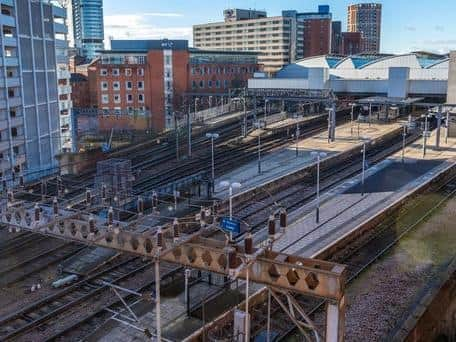Transport series: Why does Leeds City Centre only have one rail station?
and live on Freeview channel 276
Rail passengers in Leeds are set to see huge changes to Leeds City Station over the coming years, as plans for new high speed rail routes from north to south (HS2) and east to west (Northern Powerhouse Rail) continue to take shape.
Recent reports claimed Leeds station would have to expand significantly in the coming years if it is to accommodate the new high speed lines, as well as the continuing rise, Covid notwithstanding, of commuters travelling in and out of the city centre.
Advertisement
Hide AdAdvertisement
Hide AdBut how has Leeds city centre left itself with only have one rail station? Didn’t it used to have loads of them like Manchester?


The first railway to open in Leeds was the Marsh Lane to Selby line in 1834. By 1870, the railway boom led to 10 individual lines serving Leeds, connecting the city to such destinations as Manchester, the north Midlands, Selby, Thirsk, York and Halifax.
At the end of the 19th century, Leeds city centre alone boasted half a dozen rail stations – Marsh Lane, Hunslet Lane, Wellington Road, Leeds Central, Holbeck and Leeds New.
Alan J Haigh, writing in Railways and Tramways in the City of Leeds, said: “The railways were one of the largest employers in the city.
Advertisement
Hide AdAdvertisement
Hide Ad“Of central Leeds stations, both Wellington and New had more than 200 staff, with a further 130 at Leeds Central and 60 at Holbeck. Even suburban stations would have a dozen or so employees to handle passenger and freight traffic.”
However, swathes of both urban and suburban rail stations were closed between the Second World War and the mid-1960s, with the deep cuts led by then-British Rail chairman Dr Richard Beeching being the final nail in the coffin for many smaller rail lines.
But Leeds University transport expert Dr Anthony Whiteing believes Leeds was not as badly hit as other cities by such a shift.
He said: “You had more than one station in Leeds city centre and several smaller ones further out. The smaller stations tended to get closed because in terms of fares and services, they didn’t compete well with buses.
Advertisement
Hide AdAdvertisement
Hide Ad“Once you had the Beeching cuts, by the mid-60s, Leeds wasn’t hit as badly as other parts of the country, because it didn’t have such a dense network to begin with.
“Rail travel was at a low ebb and frequency was so poor. You go there in normal times now and you are practically being pushed over by crowds coming out of the station.
“It wasn’t like that at all. There wasn’t a sea of commuting into Leeds, with the growth in the service sector. It’s only in fairly recent times that the station has been swamped with growth.”
The Government had previously committed to delivering HS2 Phase 2b (which links London with Leeds and Manchester) and the Northern Powerhouse Rail scheme (linking Liverpool to Hull via Leeds), although details and projected completion dates are sketchy and uncertain.
Advertisement
Hide AdAdvertisement
Hide AdNorthern Powerhouse Rail – also informally known as HS3 – is also some way off work starting, with the line unlikely to be completed for decades.
Regional leaders were also told back in July that Leeds City Station would become busier than London Kings Cross in just three years, and that it was facing a race against time to expand before it became unfit for purpose.
Dr Whiteing said: “They are basically running out of platforms because they need to get more trains in.
“HS2 isn’t so much about work commuting – it’s about long-distance connectivity to London, where time-saving seems to be very important.
Advertisement
Hide AdAdvertisement
Hide Ad“The way we normally appraise transport investments is through time saving – if you say travel is quicker, you can justify it. But because the railway is so expensive to build, they have put more emphasis on the wider benefits to the Northern economy.
“That leads to an argument that connectivity across the north might be more important than connectivity to London.”
So should Northern Powerhouse Rail take priority?
“I think it is a relatively strong argument,” he said. “But the problem is that nobody knows what Northern Powerhouse Rail – or HS3 – is.
“There is a suspicion that it may not mean a new line, and it may instead be expansions to existing lines.
Advertisement
Hide AdAdvertisement
Hide Ad“If this is the case, they would need to be very major expansions. If you had an aspiration for a frequent train service between Leeds and Manchester that only takes half an hour, the same line would also have to bring in commuters from Batley and Morley.
“A new line would solve these problems, but it’s challenging to see where you are going to put it and how you are going to build it.
“There are a lot of competing issues that are difficult to resolve with one thing.”